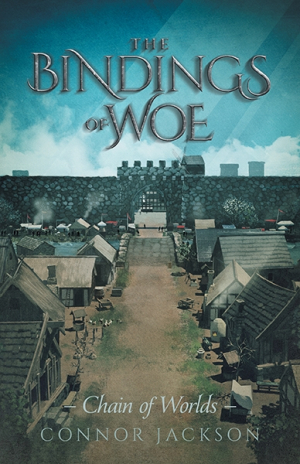The Bindings of Woe
Chain of Worlds
In the meticulous fantasy novel The Bindings of Woe, young heroes take on the godlike rulers of their oppressive government.
In Connor Jackson’s fantasy novel The Bindings of Woe, a tight-knit group of friends faces life-threatening dangers and political upheaval.
According to historical legend, Gaia was in chaos when the sovereigns arrived and restored its order. Now requiring hefty taxes and imposing oppressive rule, the sovereigns are both idolized and feared. Still, sixteen-year-old Carver, who lives with his parents and his friend Helena in a tiny rural town, resents the tax, as it eats into his community’s profits.
When Carver is mistaken as a rebel member of a supposed terrorist group during a massive attack on the annual city market, the sovereigns order Carver and Helena’s village to be destroyed to make a statement. The pair escapes with three friends, who join them in searching for safety while discerning how to reveal to the world that the beloved sovereigns are not what they seem to be. They also contemplate avenging their murdered family members and friends.
Helena is a valiant, intelligent heroine, stepping in when Carver is rendered unconscious after the attack on their town; as a result, he is absent for almost half of the book. Her curiosity and grit, along with her unending admiration of history books and the diverse cultures in Gaia, make her empathetic and powerful. Carver’s gallantry, tenacity, and wrathful angst balance out the endearing duo. Alternating chapters peek into the life of the fierce marshal who ordered the attack on Carver and Helena’s hometown, and her scenes reveal the complexity of Gaia’s political situation, even evoking sympathy for the dynamic villain.
The setting’s physical descriptions are eloquent, striking, and sharp; characters emerge from it, depend on it, and are part of it in a tangible, tactile way. Carver and Helena observe the intricacies of the city when they arrive, for instance, and compare and contrast it to their home and the ways that they live there; this shows both the details of the world of Gaia—populated by humans, sorcerers, dwarfs, goblins, and the alien-like sovereigns, among others—and the personalities of the heroes who are navigating it. Their knowledge reflects their upbringing, and as they learn more about the myriad cultures, their worldviews expand and change. Some descriptions, in particular of the physicality of the characters and their clothing, are long and extraneous, though, slowing the pace of the narrative.
The causal, somewhat modern dialogue is immersive and mirrors the characterizations throughout, though when it is used to fill in backstories or worldbuilding details, it becomes more contrived. Some scenes of characters telling stories to each other are long-winded, and long stretches in which people travel with little incident draw out the time between moments of action. But despite its pacing, the book’s rich exposition and immense world help to guide its characters through their evolutions from humble farmers to robust exemplars who boast integrity and compassion during the book’s dramatic cliffhanger ending, which will leave audiences begging for a sequel.
In the meticulous fantasy novel The Bindings of Woe, young heroes take on the godlike rulers of their oppressive government.
Reviewed by
Aimee Jodoin
Disclosure: This article is not an endorsement, but a review. The publisher of this book provided free copies of the book and paid a small fee to have their book reviewed by a professional reviewer. Foreword Reviews and Clarion Reviews make no guarantee that the publisher will receive a positive review. Foreword Magazine, Inc. is disclosing this in accordance with the Federal Trade Commission’s 16 CFR, Part 255.

